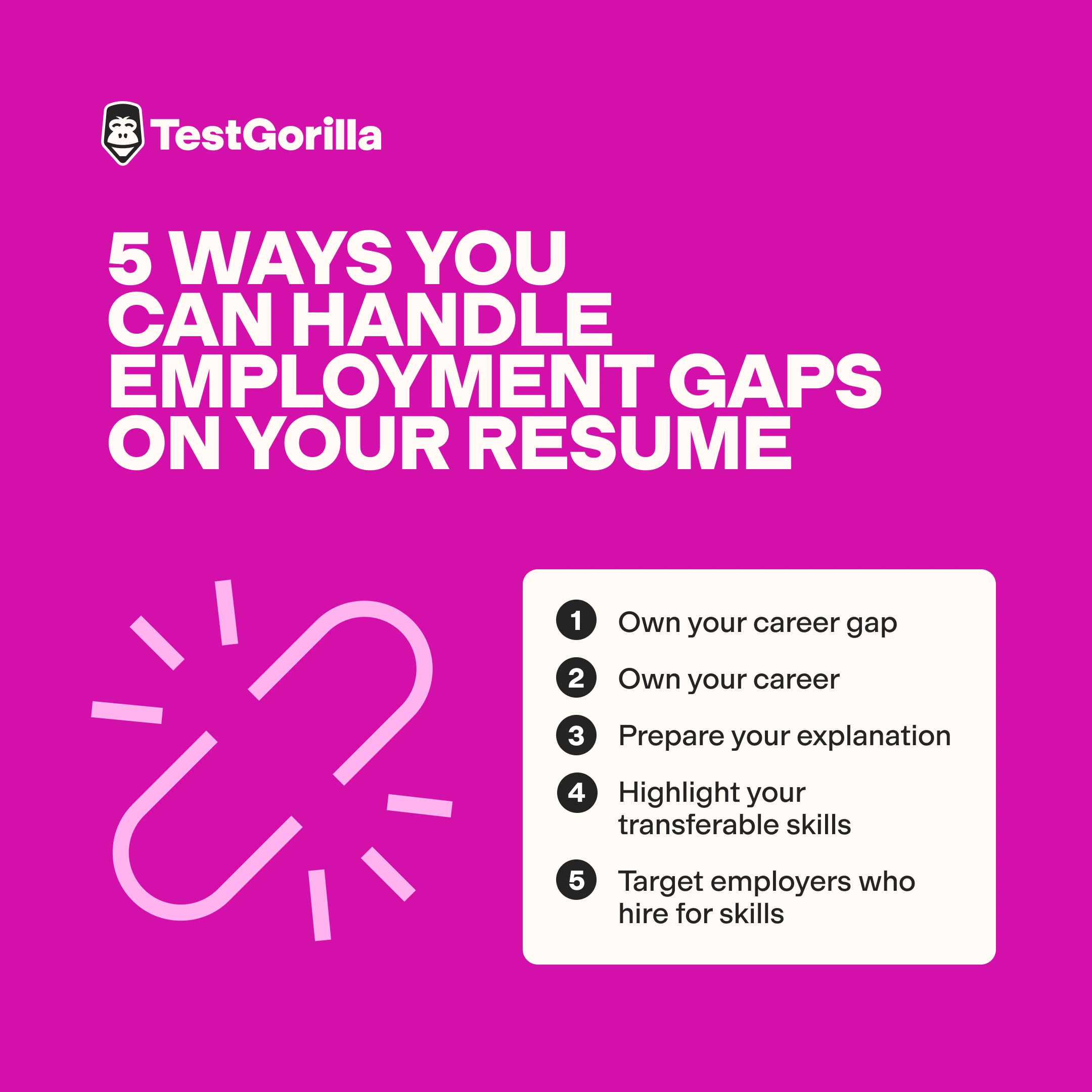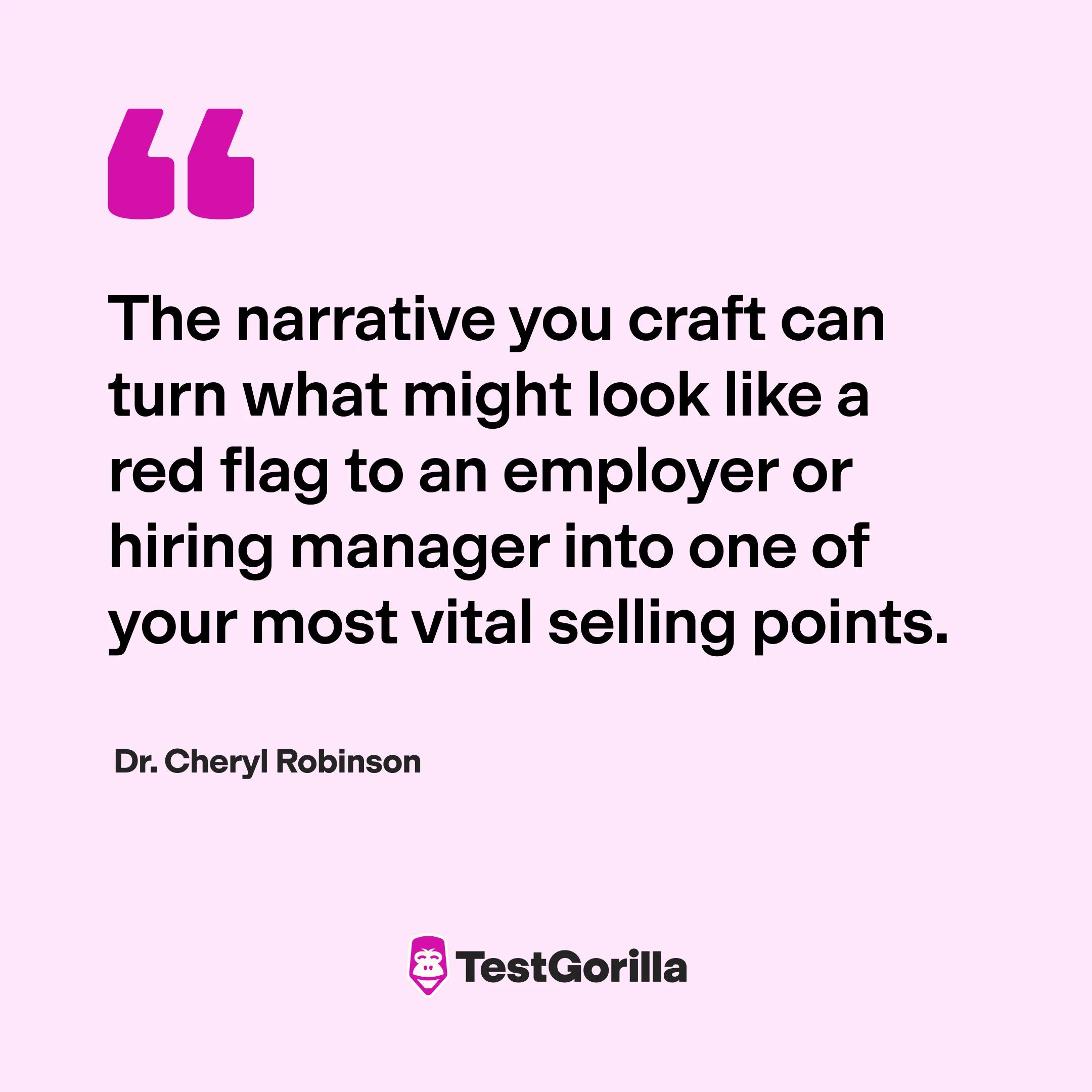In a survey across the US, UK, Australia, and the UAE, think tank Serco Institute found that 56% of respondents had taken career breaks, and these employment gaps were widespread among younger workers. [1]
Despite these gaps being common, many workers worry about how hirers perceive employment gaps and wonder how to explain them when returning to work.
In this article, we offer expert advice for addressing career gaps with potential employers – including how to turn them from red flags into unique selling points.
Key takeaways
Career gaps are periods when people don’t have formal employment. Reasons for taking a career gap include raising a family, addressing a health issue, or studying full-time.
While it’s natural to feel anxious about the impact of a break on your career and how future employers will perceive it, career gaps are increasingly common.
You can take steps to put your best foot forward when returning to work after a break. These include being open and transparent about your career gaps, highlighting your transferable skills, and finding employers who take a skills-based approach to hiring.
What is a career gap?
A career gap is a period away from the workforce. You may voluntarily take a career break to:
Raise a family
Take a “gap year” for personal development reasons – for example, when navigating a career change
Pursue other projects and opportunities – for instance, by volunteering
Study full-time
Sometimes, career breaks are involuntary. For instance, dealing with your own serious illness, having to care for a sick family member, or being laid off might result in a career gap.
Career gaps may be short – only one or two months – or could last several years.
Many worry about a break's adverse effects on their career and how potential employers will perceive them. Fortunately, employer attitudes towards career gaps are changing, and there are steps you can take to put yourself in the best position to return to work.
5 tips for addressing career gaps
Here are five ways you can handle employment gaps on your resume.
The best insights on HR and recruitment, delivered to your inbox.
Biweekly updates. No spam. Unsubscribe any time.
1. Own your career gap
Our first piece of advice? Don’t brush it under the rug.
Be honest and transparent about your time away from the workforce. Trying to cover up a career break can come across as dishonest or evasive – not a good start to a relationship with a potential employer.
Sure, you might fear that your career gap puts you at a disadvantage in the hiring process. However, while career gaps were previously viewed as red flags for employers, they’re pretty standard these days. According to LinkedIn research, 79% of hiring managers today are happy to hire candidates with career gaps.
Some employers even see them as an advantage that helps individuals develop transferable soft skills (more on that later). Gemma Davis, head of people at Ogilvy UK, shared her take with WorkLife. “We want people with different experiences who look at challenges and potential solutions from different perspectives, and those who have had a career gap often fit this bill.”
Does this mean you should mention every career gap on your resume? Not necessarily. Generally, you don’t need to include short breaks (i.e., less than six months) or breaks you took several years ago unless you’re specifically asked.
2. Maximize your time off
You can use a career break to develop or learn new skills to support your eventual return to work – even if you’re not in a formal work environment during the gap.
Some use a career break to pursue full-time studies, such as obtaining a master's degree. But even if you’re not taking a dedicated study break, there are various ways to improve and maintain your professional skills while not working. For example, you can:
Complete online courses or webinars.
Volunteer a few hours a week.
Maintain and expand your professional network – for instance, by attending industry events or catching up with former colleagues for the occasional coffee.
Subscribe to industry updates and publications to stay on top of any relevant developments.
Take some short-term contracts or part-time freelance work.
Some reasons for career breaks – like caring for a newborn or recovering from a severe illness – might make leveling up your skills impossible. However, finding opportunities like these when you can keeps your skills ticking along and gives you knowledge, abilities, and experiences to highlight in future job applications and interviews.
3. Prepare your explanation
Before submitting an application or going into an interview, put together a brief, clear explanation of your career gap. This is an opportunity to provide a potential employer with some context, highlight transferable skills you gained (more on this below), and outline your motivation for returning to the workforce.
Dr. Cheryl Robinson writes for Forbes, “The narrative you craft can turn what might look like a red flag to an employer or hiring manager into one of your most vital selling points.”
For example, if you took time off to have children, you might say, “I stepped back from my career to focus on raising a family. During this time, I developed strong organizational and time management skills. I’m now highly motivated to return to the workforce and apply these skills and my previous experience in a professional setting.”
Keep it brief and only include details you’re comfortable with. For instance, if you took time away to deal with a sensitive health issue, you might refer to it more broadly as a “health condition” when speaking with potential employers.
A prepared explanation also helps you avoid becoming defensive or apologetic about a career break during interviews. You can provide your reasons and then move on.
At the same time, you don’t need to spend 15 minutes talking about your career break. Provide your explanation and then focus on emphasizing your transferable skills and motivations.
4. Highlight your transferable skills
Focusing on your transferable skills is a great strategy when returning to work after a career break. There are ways to frame the experience you gained while taking time off, regardless of your reasons for the break. Look critically at your career gap to see which skills you developed during it. For instance:
Taking a career break to raise children helps you develop communication, multi-tasking, prioritization, and time management skills.
If you traveled during your time off, you likely built on your cross-cultural communication, adaptability, and problem-solving skills.
Time away from the workforce to manage a health issue typically develops your resilience, stress management, and emotional intelligence.
Transferable skills are skills you can easily “transfer” between different roles or industries. They’re often soft skills like responsibility, confidence, discipline, empathy, and patience. Highlight these skills in your application and resume and when answering interview questions. This approach helps employers see the positives of your career break and the value you offer as an employee.
As Jenn Lim, CEO of consultancy Delivering Happiness, says to CNBC, “Don’t discount the experiences gained during a career break, and give credit to the life skills we experience that can’t be found in a training & development course… soft skills are in great demand.”
5. Target employers who hire for skills
When returning to work after a career break, look for employers who use skills-based hiring. These employers use skills-based approaches – like skills tests – to find candidates with the qualities they need. They’re usually more likely to recognize the value employees with career gaps offer.
After all, a skills-based approach to hiring is much more reliable than resumes when finding the best person for the job. According to TestGorilla’s 2024 State of Skills-Based Hiring Report, 98% of employers said using skills-based hiring is better for finding talented candidates than screening their resumes.
So, how do you find these employers? Tell-tale signs of employers who prioritize skills include:
Skills-centric job posts. Most of the job post focuses on core competencies over formal qualifications or niche experience. It refers to qualifications as “preferred” rather than “required.” The job post may even state that the employer welcomes applicants with non-linear/non-traditional backgrounds.
The use of skills assessments during the hiring process. These give employers unbiased insights into candidates’ skills and other qualities to aid their hiring decisions.
Dedicated return-to-work programs for employees. Check a potential employer’s website to see whether they offer a structured program to help employees re-enter the workforce after an extended break with strategies like mentoring, flexible work arrangements, and targeted training.
You can also easily find employers who take a skills-first approach to hiring on TestGorilla’s remote jobs board. The job posts on our board don’t require any detailed written application or even a resume. Interested in a role? Simply ask to complete the employer’s TestGorilla assessment.
Capitalize on your career gap – and get your dream job
Returning to work after a career break can feel daunting. Whether you took a voluntary break to raise a family, study, travel, or needed time away from work due to illness or layoff, it’s natural to worry about how employers will perceive your time off.
The good news? Career gaps are more common now and less likely to raise a red flag than in the past. You can also take steps to help your return to the workforce, including being upfront and transparent about your career breaks, building on your skills during your time off, and seeking out employers who prioritize skills in the hiring process.
To get started, check out TestGorilla’s remote jobs board or learn more about skills-based hiring and how it can help you return to work at our job seeker hub. And if you’re invited to take an assessment, check out our assessment guide.
FAQs
Is it necessary to mention a career gap in a resume?
While you should be transparent about career breaks with potential employers, mentioning every career gap you’ve had is unnecessary. For example, unless specifically asked, you probably don’t need to detail a career gap from 10 years ago or a short three-month career gap.
How long of a job gap is ok?
There’s no strict rule on how long a career break is acceptable to employers. What matters most is how you frame it when reentering the workforce. Highlight the transferable skills you developed during the gap and your motivations for returning to work in job applications and interviews.
Sources:
[1] “Breaking Point: Attitudes towards ‘career breaks’ across four countries & how to create a system fit for purpose.” (2022). Serco Institute. https://www.sercoinstitute.com/research/2022/breaking-point-attitudes-towards-career-breaks-across-four-countries-how-to-create-a-system-fit-for-purpose
You've scrolled this far
Why not try TestGorilla for free, and see what happens when you put skills first.
















